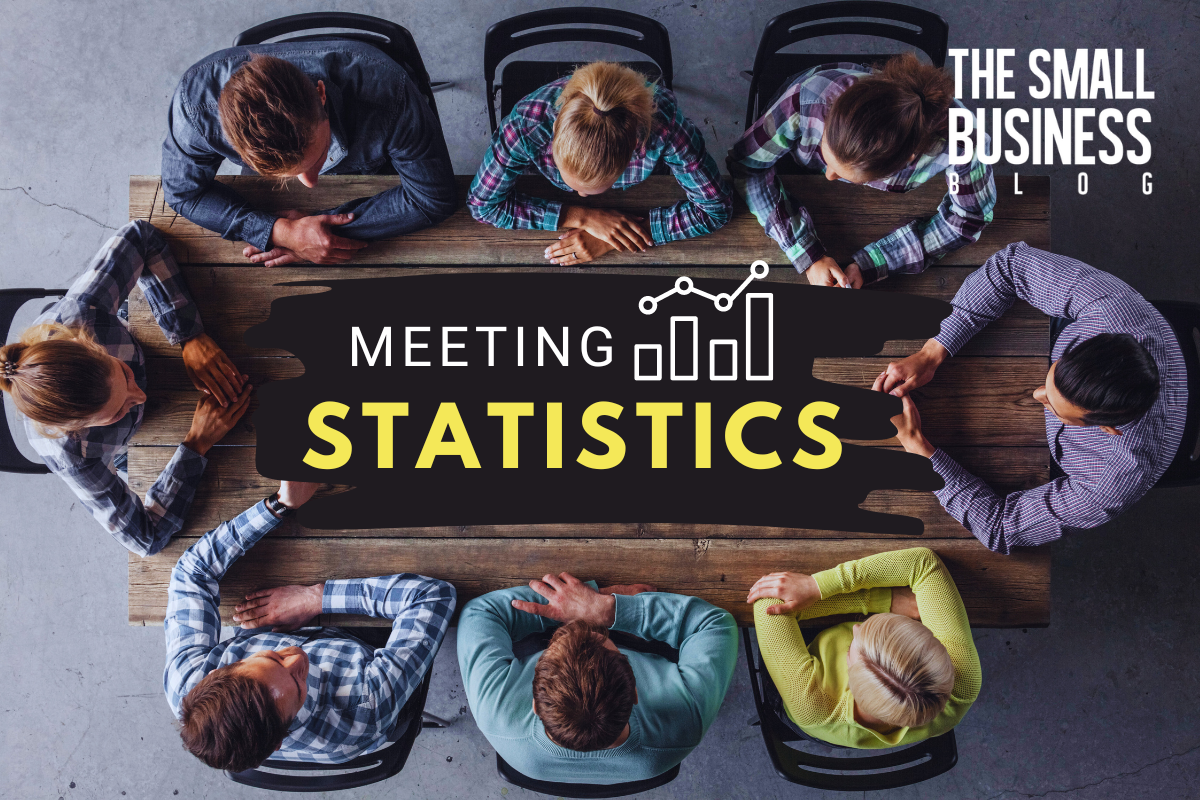Meetings are an inevitable part of life in the workplace, but how productive are they?
Today, we are looking at meetings and statistics and other data about workplace meetings.
Workplace meetings allow employees a way to collaborate, share information, and make decisions.
However, they can also be a major time waster, and if they’re not well-run, they can be unproductive and frustrating.
In this article, we’ll look at some meeting statistics that will help you understand how much time you’re spending in meetings, how productive those meetings are, and what you can do to make your meetings more effective.
Post Contents
- 1 Key Statistics
- 2 Meeting Statistics in 2024
- 2.1 1. On Average, 11 Million Meetings Are Held Daily in The United States.
- 2.2 2. The Average Executive Spends 23 Hours per Week in Meetings.
- 2.3 3. Only 37% of Workplace Meetings Have Clear Goals and Objectives.
- 2.4 4. the Average Delay per Workplace Meeting Accounts for Over 10 Minutes.
- 2.5 5. 55% of Employees Say that Coworkers Who Take Phone Calls and Texts During Meetings Make a Meeting Bad.
- 2.6 6. 55% of Remote Employees Feel that Most Meetings Could Be an Email Instead.
- 2.7 7. A Whopping 24 Billion Hours Are Wasted Every Year on Unproductive Meetings.
- 2.8 8. 96% of Employees Have Missed Work Meetings.
- 2.9 9. Over the Past 20 Years, the Time Spent in Work Meetings Has Risen.
- 2.10 10. 47.11% of Remote Workers and 49.67% of On-Site Workers Prefer In-Person Meetings.
- 2.11 11. Zoom Meeting Participation Has Grown by 20 Times Since the Pandemic.
- 2.12 12. Zoom Fatigue Is Real and Negatively Impacts 58% of Introverts and 40% of Extroverts.
- 2.13 13. Between 2020 and 2021, the Average Workplace Meeting Length Declined by 20.1%.
- 2.14 14. 35% of Survey Respondents Said that Having Fewer People in The Meeting Makes It More Successful.
- 2.15 15. Interestingly, the “Two-Pizza” Rule Leads to More Productive Work Meetings.
- 2.16 16. In Terms of Monetary Loss, a One-Hour Meeting with Only 5 Attendees Can Cost $338 (USD).
- 2.17 17. 44% of Workers Who Attended Meetings Say They Don’t Have Enough Time to Finish Their Work.
- 2.18 18. 15% of Remote Employees Clean Their House and Do Other Household Chores
- 3 FAQs
- 3.1 How Much Time Do Employees Spend in Meetings Each Week?
- 3.2 What Percentage of Meetings Are Productive?
- 3.3 What Are the Most Common Reasons for Unproductive Meetings?
- 3.4 What Can Be Done to Make Meetings More Productive?
- 3.5 What Are the Benefits of Running Effective Meetings?
- 3.6 What Are Some Tips for Running Effective Meetings?
- 4 Conclusion
- 5 Sources
Key Statistics
- On average, 11 million meetings are held daily in the United States.
- The average executive spends 23 hours per week in meetings.
- Only 37% of workplace meetings have clear goals and objectives.
- The average delay per workplace meeting accounts for over 10 minutes.
- 55% of employees say that coworkers who take phone calls and texts during meetings make a meeting bad.
- 55% of remote employees feel that most meetings could be an email instead.
- A whopping 24 billion hours are wasted every year to unproductive meetings.
- 96% of employees have missed work meetings.
- Over the past 20 years, the time spent in work meetings has risen.
- 47.11% of remote workers and 49.67% of on-site workers prefer in-person meetings.
Meeting Statistics in 2024

1. On Average, 11 Million Meetings Are Held Daily in The United States.
In the United States, 11 million meetings are held daily, which represents between 55 million meetings every week and over 1 billion per year.
Data shows that 83.13% of employees spend up to one-third of their weekly work hours in meetings.
Meetings may be a fact of life in the workplace, but not every meeting is productive.
If they’re not well-run, they can be unproductive and frustrating, making meetings a waste of your time.
(Zippia)
2. The Average Executive Spends 23 Hours per Week in Meetings.
When executives are spending 23 hours in meetings every week, that time takes up more than half of their workweek in terms of a 40-hour a day job.
The average executive and employee spends a significant amount of time in meetings.
This can be a major drain on productivity, especially if the meetings are not productive.
(Golden Step ABA)
3. Only 37% of Workplace Meetings Have Clear Goals and Objectives.
A survey among employees, 37% of respondents said their meetings included a clear agenda.
These are unproductive meetings.
This means that many meetings are either unproductive or a complete waste of time. A good percentage of meetings are unproductive.
This is a problem as it wastes time and resources which can result in frustration and decreased productivity.
(99Firms)
4. the Average Delay per Workplace Meeting Accounts for Over 10 Minutes.
According to data, the average workplace meeting delay for workers accounts for 10 minutes and 40 seconds per meeting.
This can represent 3 days and 2 hours lost at least per year.
If the average is 23 hours in meetings per week, this equals over 3 hours in wasted work time.
In terms of executive meetings, 15 minutes and 42 seconds is the average delay, which is equivalent to 5 days and 19 hours yearly.
(Booqed)
5. 55% of Employees Say that Coworkers Who Take Phone Calls and Texts During Meetings Make a Meeting Bad.
While there may be worse things in life than interrupted meetings due to coworkers taking phone calls and texts during meetings, 55% say it’s irritating.
So, more than half of the employees surveyed said phone usage during work meetings is irritating.
Another 50% said meeting participants interrupting one another makes a meeting bad.
Anything that’s disruptive made the list like late arrivals, not listening, leaving early, and small talk.
(Better Meetings)
6. 55% of Remote Employees Feel that Most Meetings Could Be an Email Instead.
In the remote working realm, 55% of remote workers think that most meetings could be an email instead.
In fact, data shows that during 14% of meetings, 55% of remote workers multitask by checking emails, reading email, and answering emails.
Furthermore, just over 50% of them also
multitask in other ways and handle texts and phone calls.
(Airgram, Zippia)
7. A Whopping 24 Billion Hours Are Wasted Every Year on Unproductive Meetings.
Imagine how much could be done in workplaces in 24 billion hours a year instead of those hours being wasted in less than productive meetings.
With the formerly mentioned delays in meetings that occur and wasted time in meetings, perhaps some meetings aren’t worth the time.
However, if these meetings have a clear agenda and purpose, less time is wasted.
(Cross River Therapy)
8. 96% of Employees Have Missed Work Meetings.

We know employees feel irritated when employees show up late, leave early, use their phones during meetings, and other disruptions.
What about the fact that 96% of employees have chosen to miss meetings?
If meetings are to be productive, workers need to be there to participate, listen, and learn.
How else can they be kept updated on what’s happening? Besides this, 91% daydream during meetings, 73% work on other tasks, and 39% fall asleep.
(TrueList)
9. Over the Past 20 Years, the Time Spent in Work Meetings Has Risen.
During the pandemic, we saw a 20% decrease in the average length of workplace meetings.
However, in terms of the past 20 years, employees have been spending more time in meetings.
The Harvard Business Review revealed that 70% of all work meetings prevent workers from completing their tasks at work.
This is dued to the 13.5% rise in the number of meetings.
(Harvard Business Review, TeamStage)
10. 47.11% of Remote Workers and 49.67% of On-Site Workers Prefer In-Person Meetings.
By almost equal percentages, among Millennial and Gen X remote workers (46.11%) and on-site workers (46.67%) said they preferred in-person meetings over virtual meetings.
When we look at the Baby Boomers they prefer in-person meetings even more among remote (51.38%) and on-site (47.51%) workers.
Data also shows that 47.92% of remote and 50.58% of on-site Gen Z remote workers value in-person meetings.
Age does matter in this instance.
(Better Meetings, Zippia)
11. Zoom Meeting Participation Has Grown by 20 Times Since the Pandemic.
There has been an enormous uptake in Zoom meetings since the global pandemic.
Just like the demand for remote home workers, businesses increased their use of the Zoom meeting platform.
In 2019, 10 million daily meetings were conducted via Zoom.
By 2020, that figure came to 200 million. That really puts the uptake in virtual meetings in perspective.
(EnterpriseAppsToday)
12. Zoom Fatigue Is Real and Negatively Impacts 58% of Introverts and 40% of Extroverts.
Whether employees are introverted or extroverted, Zoom meetings are causing levels of fatigue among employees.
Prior to the pandemic and the increased usage of virtual meetings and engagement, there was little to no research to analyze and measure the effects of Zoom and other such platforms.
While this data is still in its beginnings, already it’s known that Zoom fatigue is real and has side effects.
In a survey, 58% of introverts said they have Zoom fatigue and 40% of extroverts also say they have it.
(Airgram, The Atlantic)
13. Between 2020 and 2021, the Average Workplace Meeting Length Declined by 20.1%.
While we have seen the massive figures on wasted time in meetings and the lack of productive meetings, the overall average length of work meetings has declined by 20.1% since 2020.
Somewhere between 2020 and 2021, the amount of time spent in meetings, virtual or in-person, declined.
However, during this same period, the average time per week in meetings rose.
(99Firms, The Conversation)
14. 35% of Survey Respondents Said that Having Fewer People in The Meeting Makes It More Successful.
According to a survey of employees, 35% of them said they think having fewer people in the meeting helps to make it productive and more successful.
Moreover, 67% of respondents said that a good meeting needs to have a clear agenda and 72% of professional workers believe that having clear goals and objectives are crucial to a good and productive meeting.
(Booqed, TrueList)
15. Interestingly, the “Two-Pizza” Rule Leads to More Productive Work Meetings.
What’s the “two-pizza” rule? This is the concept that you shouldn’t hold a meeting if two pizzas won’t feed everyone.
In fact, this is the meeting rule that Amazon’s CED Jeff Bezos follows.
So, not only do employees think that fewer people make better meetings, but the statistics also show that it’s true.
(TeamStage)
16. In Terms of Monetary Loss, a One-Hour Meeting with Only 5 Attendees Can Cost $338 (USD).
Time isn’t the only thing lost in work meetings, especially unproductive and inappropriately planned meetings.
Workplace meetings cost money.
In fact, the average salary expense of a one-hour meeting where 5 employees are in attendance accounts for $338.
When analyzing video meetings this figure jumps to $1,250 per month per worker.
These numbers are in terms of wasted time in meetings.
(Booqed)
17. 44% of Workers Who Attended Meetings Say They Don’t Have Enough Time to Finish Their Work.

When we are talking about poorly attempted meetings, 44% of attendees say they can’t do the rest of their work due to time.
Another 43% say that they are left confused by unclear directives in a work meeting.
The loss of focus on projects due to poor meeting organization was another consequence of ineffective meetings according to 38% of respondents.
Furthermore, 31% of meeting attendees said that unnecessary attendees slow down the meeting’s progress.
(Cross River Therapy)
18. 15% of Remote Employees Clean Their House and Do Other Household Chores
Besides checking emails, their phones, remote workers also multitask by getting household chores done.
These are distractions that occur at some level for home workers.
While this percentage is low, it still exists and it makes meetings less effective when workers aren’t paying attention.
Some things they do during a meeting may include taking a jog, handling pets, taking care of their child/children, etc.
Some of these only account for 10% of remote worker respondents.
(Zippia)
FAQs
How Much Time Do Employees Spend in Meetings Each Week?
According to a study by Doodle, the average employee spends 23 hours per week in meetings.
This is more than half of a 40-hour work week. No matter how you slice it, this is egregious.
What Percentage of Meetings Are Productive?
A study by The Atlantic found that only 37% of meetings are productive.
This data tells us that the majority of meetings are either unproductive or a total waste of time.
What Are the Most Common Reasons for Unproductive Meetings?
The most common reasons for unproductive meetings include:
• Lack of clear goals or objectives
• Poor planning
• Irrelevant or excessive discussion
• Unfocused or wandering conversations
• Lack of participation from all attendees
What Can Be Done to Make Meetings More Productive?
There are several things that can be done to make meetings more productive, like the following:
• Clearly define the goals and objectives of the meeting
• Do your homework and come prepared
• Keep the meeting focused and on track
• Encourage participation from all attendees
• Summarize the key points at the end of the meeting
What Are the Benefits of Running Effective Meetings?
There are many benefits to running effective meetings, which include:
• Increased productivity
• Improved decision-making
• Enhanced collaboration
• Reduced stress and frustration
• Increased employee satisfaction
What Are Some Tips for Running Effective Meetings?
Here are some tips for enjoying effective/productive meetings:
• Start and end on time
• Set clear expectations
• Be prepared
• Encourage participation
• Summarize the key points at the end of the meeting
• Follow up on action items
Conclusion
Workplace meetings are a necessary part of the workplace, but they can also be a major waste of time when they aren’t conducted properly.
We know that on average, employees spend 23 hours each week in workplace meetings, which is more than half the 40-hour work week.
Out of those hours spent in meetings, only 37% are even productive.
Making sure your meetings are productive with clear goals and objectives allows you to stay focused and keep the meeting focused to come to better decisions.
Be sure to include and encourage everyone’s participation.
By understanding the statistics and tips presented in this article, you can make your meetings more productive and efficient.
I hope this article has helped you learn more about meeting statistics and how to make your meetings more productive.






























